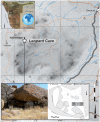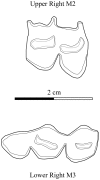"Of sheep and men": earliest direct evidence of caprine domestication in southern Africa at Leopard Cave (Erongo, Namibia)
- PMID: 22808138
- PMCID: PMC3394794
- DOI: 10.1371/journal.pone.0040340
"Of sheep and men": earliest direct evidence of caprine domestication in southern Africa at Leopard Cave (Erongo, Namibia)
Abstract
The origins of herding practices in southern Africa remain controversial. The first appearance of domesticated caprines in the subcontinent is thought to be c. 2000 years BP; however, the origin of this cultural development is still widely debated. Recent genetic analyses support the long-standing hypothesis of herder migration from the north, while other researchers have argued for a cultural diffusion hypothesis where the spread of herding practices took place without necessarily implicating simultaneous and large population movements. Here we document the Later Stone Age (LSA) site of Leopard Cave (Erongo, Namibia), which contains confirmed caprine remains, from which we infer that domesticates were present in the southern African region as early as the end of the first millennium BC. These remains predate the first evidence of domesticates previously recorded for the subcontinent. This discovery sheds new light on the emergence of herding practices in southern Africa, and also on the possible southward routes used by caprines along the western Atlantic coast.
Conflict of interest statement
Figures




References
Publication types
MeSH terms
Substances
LinkOut - more resources
Full Text Sources

